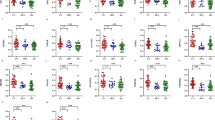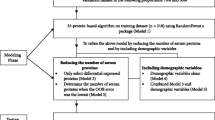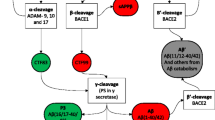Abstract
Alzheimer’s disease (AD) is the most common cause of dementia worldwide with 10–30% prevalence in aging population and a high socioeconomic impact. Because AD definitive diagnostic requires post-mortem verification, new approaches to study the disease are necessary. Here, we analyze the humoral immune response in AD to survey whether APP+1 or UBB+1 frameshift proteins, produced as a consequence of the “molecular misreading” alteration in AD occurring in the APP (amyloid precursor protein) and UBB (ubiquitin-B protein) proteins’ mRNA, elicit the production of autoantibodies specific of AD. To this end, APP+1 and UBB+1 peptides were expressed in bacteria as 6xHisHalo fusion proteins and after purification to homogeneity their seroreactivity was analyzed using 81 individual sera from AD patients and 43 individual sera from healthy individuals by luminescence beads immunoassay. We found that as a result of the molecular misreading, APP+1 and UBB+1 frameshift peptides produced a humoral immune response in AD patients, whose autoantibody levels are significantly higher in comparison with healthy controls. Their combination with a previously reported panel of four autoantigens specific of AD (ANTXR1, OR8J1, PYGB, and NUPR1) increased their diagnostic ability assessed by receiver operating characteristic (ROC) curves up to an area under the curve (AUC) of 73.5%. Collectively, our results demonstrate that APP+1 and UBB+1 frameshift proteins, non-previously described as AD-specific autoantigens, elicit the production of autoantibodies which might be useful as blood-based biomarkers to aid in the detection of the disease.





Similar content being viewed by others
References
Masters CL, Bateman R, Blennow K, Rowe CC, Sperling RA, Cummings JL (2015) Alzheimer’s disease. Nat Rev Dis Primers 1:15056. https://doi.org/10.1038/nrdp.2015.56
Sibener L, Zaganjor I, Snyder HM, Bain LJ, Egge R, Carrillo MC (2014) Alzheimer’s disease prevalence, costs, and prevention for military personnel and veterans. Alzheimers Dement 10(3 Suppl):S105–S110. https://doi.org/10.1016/j.jalz.2014.04.011
Mayeux R, Stern Y (2012) Epidemiology of Alzheimer disease. Cold Spring Harb Perspect Med 2(8). https://doi.org/10.1101/cshperspect.a006239
Tanzi RE (2012) The genetics of Alzheimer disease. Cold Spring Harb Perspect Med 2(10). https://doi.org/10.1101/cshperspect.a006296
Goedert M, Spillantini MG (2006) A century of Alzheimer’s disease. Science 314(5800):777–781. https://doi.org/10.1126/science.1132814
Himmler A, Drechsel D, Kirschner MW, Martin DW Jr (1989) Tau consists of a set of proteins with repeated C-terminal microtubule-binding domains and variable N-terminal domains. Mol Cell Biol 9(4):1381–1388
O'Brien RJ, Wong PC (2011) Amyloid precursor protein processing and Alzheimer’s disease. Annu Rev Neurosci 34:185–204. https://doi.org/10.1146/annurev-neuro-061010-113613
Mattson MP (2004) Pathways towards and away from Alzheimer’s disease. Nature 430(7000):631–639. https://doi.org/10.1038/nature02621
Albert MS, DeKosky ST, Dickson D, Dubois B, Feldman HH, Fox NC, Gamst A, Holtzman DM et al (2011) The diagnosis of mild cognitive impairment due to Alzheimer’s disease: recommendations from the National Institute on Aging-Alzheimer’s Association workgroups on diagnostic guidelines for Alzheimer’s disease. Alzheimers Dement 7(3):270–279. https://doi.org/10.1016/j.jalz.2011.03.008
Giannakopoulos P, Herrmann FR, Bussiere T, Bouras C, Kovari E, Perl DP, Morrison JH, Gold G et al (2003) Tangle and neuron numbers, but not amyloid load, predict cognitive status in Alzheimer’s disease. Neurology 60(9):1495–1500
Jack CR Jr, Knopman DS, Jagust WJ, Shaw LM, Aisen PS, Weiner MW, Petersen RC, Trojanowski JQ (2010) Hypothetical model of dynamic biomarkers of the Alzheimer's pathological cascade. The Lancet Neurology 9(1):119–128. https://doi.org/10.1016/S1474-4422(09)70299-6
Verberk IMW, Slot RE, Verfaillie SCJ, Heijst H, Prins ND, van Berckel BNM, Scheltens P, Teunissen CE et al (2018) Plasma amyloid as prescreener for the earliest Alzheimer pathological changes. Ann Neurol 84(5):648–658. https://doi.org/10.1002/ana.25334
San Segundo-Acosta P, Montero-Calle A, Fuentes M, Rabano A, Villalba M, Barderas R (2019) Identification of Alzheimer’s disease autoantibodies and their target biomarkers by phage microarrays. J Proteome Res. https://doi.org/10.1021/acs.jproteome.9b00258
Nagele E, Han M, Demarshall C, Belinka B, Nagele R (2011) Diagnosis of Alzheimer’s disease based on disease-specific autoantibody profiles in human sera. PLoS One 6(8):e23112. https://doi.org/10.1371/journal.pone.0023112
van Leeuwen FW, de Kleijn DP, van den Hurk HH, Neubauer A, Sonnemans MA, Sluijs JA, Koycu S, Ramdjielal RD et al (1998) Frameshift mutants of beta amyloid precursor protein and ubiquitin-B in Alzheimer’s and Down patients. Science 279(5348):242–247
Hershko A, Ciechanover A (1998) The ubiquitin system. Annu Rev Biochem 67:425–479. https://doi.org/10.1146/annurev.biochem.67.1.425
van Leeuwen FW (2004) Neuropeptide research discloses part of the secrets of Alzheimer’s disease neuropathogenesis: state of the art 2004. Neurosci Lett 361(1-3):124–127. https://doi.org/10.1016/j.neulet.2003.12.050
van Leeuwen FW, Fischer DF, Kamel D, Sluijs JA, Sonnemans MA, Benne R, Swaab DF, Salehi A et al (2000) Molecular misreading: a new type of transcript mutation expressed during aging. Neurobiol Aging 21(6):879–891
van Dijk R, Fischer DF, Sluijs JA, Sonnemans MA, Hobo B, Mercken L, Mann DM, Hol EM et al (2004) Frame-shifted amyloid precursor protein found in Alzheimer’s disease and Down’s syndrome increases levels of secreted amyloid beta40. J Neurochem 90(3):712–723. https://doi.org/10.1111/j.1471-4159.2004.02528.x
Hol EM, van Dijk R, Gerez L, Sluijs JA, Hobo B, Tonk MT, de Haan A, Kamphorst W et al (2003) Frameshifted beta-amyloid precursor protein (APP+1) is a secretory protein, and the level of APP+1 in cerebrospinal fluid is linked to Alzheimer pathology. J Biol Chem 278(41):39637–39643. https://doi.org/10.1074/jbc.M302295200
Anderson KS, LaBaer J (2005) The sentinel within: exploiting the immune system for cancer biomarkers. J Proteome Res 4(4):1123–1133. https://doi.org/10.1021/pr0500814
Clark LF, Kodadek T (2016) The immune system and neuroinflammation as potential sources of blood-based biomarkers for Alzheimer’s disease, Parkinson’s disease, and Huntington’s disease. ACS Chem Neurosci 7(5):520–527. https://doi.org/10.1021/acschemneuro.6b00042
Soussi T (2000) p53 Antibodies in the sera of patients with various types of cancer: a review. Cancer Res 60(7):1777–1788
Garranzo-Asensio M, Guzman-Aranguez A, Poves C, Fernandez-Acenero MJ, Torrente-Rodriguez RM, Ruiz-Valdepenas Montiel V, Dominguez G, Frutos LS et al (2016) Toward liquid biopsy: determination of the humoral immune response in cancer patients using HaloTag fusion protein-modified electrochemical bioplatforms. Anal Chem 88(24):12339–12345. https://doi.org/10.1021/acs.analchem.6b03526
Martinez-Martin P, Avila J, Investigators ADRU (2010) Alzheimer Center Reina Sofia Foundation: fighting the disease and providing overall solutions. J Alzheimers Dis 21(2):337–348. https://doi.org/10.3233/JAD-2010-101149
Hyman BT, Phelps CH, Beach TG, Bigio EH, Cairns NJ, Carrillo MC, Dickson DW, Duyckaerts C et al (2012) National Institute on Aging-Alzheimer’s Association guidelines for the neuropathologic assessment of Alzheimer's disease. Alzheimers Dement 8(1):1–13. https://doi.org/10.1016/j.jalz.2011.10.007
Mirra SS, Hart MN, Terry RD (1993) Making the diagnosis of Alzheimer’s disease. A primer for practicing pathologists. Arch Pathol Lab Med 117(2):132–144
Thal DR, Rub U, Orantes M, Braak H (2002) Phases of A beta-deposition in the human brain and its relevance for the development of AD. Neurology 58(12):1791–1800
Throop ALJ (2001) Gateway technology. Curr Protocol Mol Biol 110:1–35
Garranzo-Asensio M, San Segundo-Acosta P, Martinez-Useros J, Montero-Calle A, Fernandez-Acenero MJ, Haggmark-Manberg A, Pelaez-Garcia A, Villalba M et al (2018) Identification of prefrontal cortex protein alterations in Alzheimer’s disease. Oncotarget 9(13):10847–10867. https://doi.org/10.18632/oncotarget.24303
Olsson B, Lautner R, Andreasson U, Ohrfelt A, Portelius E, Bjerke M, Holtta M, Rosen C et al (2016) CSF and blood biomarkers for the diagnosis of Alzheimer’s disease: a systematic review and meta-analysis. The Lancet Neurology 15(7):673–684. https://doi.org/10.1016/s1474-4422(16)00070-3
Blennow K (2017) A review of fluid biomarkers for Alzheimer’s disease: moving from CSF to blood. Neurology and therapy 6(Suppl 1):15–24. https://doi.org/10.1007/s40120-017-0073-9
DeMarshall C, Sarkar A, Nagele EP, Goldwaser E, Godsey G, Acharya NK, Nagele RG (2015) Utility of autoantibodies as biomarkers for diagnosis and staging of neurodegenerative diseases. Int Rev Neurobiol 122:1–51. https://doi.org/10.1016/bs.irn.2015.05.005
Levin EC, Acharya NK, Han M, Zavareh SB, Sedeyn JC, Venkataraman V, Nagele RG (2010) Brain-reactive autoantibodies are nearly ubiquitous in human sera and may be linked to pathology in the context of blood-brain barrier breakdown. Brain Res 1345:221–232. https://doi.org/10.1016/j.brainres.2010.05.038
Nagele RG, Clifford PM, Siu G, Levin EC, Acharya NK, Han M, Kosciuk MC, Venkataraman V et al (2011) Brain-reactive autoantibodies prevalent in human sera increase intraneuronal amyloid-beta(1-42) deposition. J Alzheimers Dis 25(4):605–622. https://doi.org/10.3233/JAD-2011-110098
Absinta M, Ha SK, Nair G, Sati P, Luciano NJ, Palisoc M, Louveau A, Zaghloul KA et al (2017) Human and nonhuman primate meninges harbor lymphatic vessels that can be visualized noninvasively by MRI. ELife 6. https://doi.org/10.7554/eLife.29738
Aspelund A, Antila S, Proulx ST, Karlsen TV, Karaman S, Detmar M, Wiig H, Alitalo K (2015) A dural lymphatic vascular system that drains brain interstitial fluid and macromolecules. J Exp Med 212(7):991–999. https://doi.org/10.1084/jem.20142290
Iliff JJ, Goldman SA, Nedergaard M (2015) Implications of the discovery of brain lymphatic pathways. The Lancet Neurology 14(10):977–979. https://doi.org/10.1016/s1474-4422(15)00221-5
Jessen NA, Munk AS, Lundgaard I, Nedergaard M (2015) The glymphatic system: a beginner’s guide. Neurochem Res 40(12):2583–2599. https://doi.org/10.1007/s11064-015-1581-6
Villanueva J, Shaffer DR, Philip J, Chaparro CA, Erdjument-Bromage H, Olshen AB, Fleisher M, Lilja H et al (2006) Differential exoprotease activities confer tumor-specific serum peptidome patterns. J Clin Invest 116(1):271–284. https://doi.org/10.1172/JCI26022
Wu J, Li L (2016) Autoantibodies in Alzheimer’s disease: potential biomarkers, pathogenic roles, and therapeutic implications. J Biomed Res 30(5):361–372. https://doi.org/10.7555/JBR.30.20150131
van Leeuwen FW, Burbach JP, Hol EM (1998) Mutations in RNA: a first example of molecular misreading in Alzheimer’s disease. Trends Neurosci 21(8):331–335
Roy S, Zhang B, Lee VM, Trojanowski JQ (2005) Axonal transport defects: a common theme in neurodegenerative diseases. Acta Neuropathol 109(1):5–13. https://doi.org/10.1007/s00401-004-0952-x
De Vrij FM, Sluijs JA, Gregori L, Fischer DF, Hermens WT, Goldgaber D, Verhaagen J, Van Leeuwen FW et al (2001) Mutant ubiquitin expressed in Alzheimer’s disease causes neuronal death. FASEB J 15(14):2680–2688. https://doi.org/10.1096/fj.01-0438com
Lam YA, Pickart CM, Alban A, Landon M, Jamieson C, Ramage R, Mayer RJ, Layfield R (2000) Inhibition of the ubiquitin-proteasome system in Alzheimer’s disease. Proc Natl Acad Sci U S A 97(18):9902–9906. https://doi.org/10.1073/pnas.170173897
Lindsten K, de Vrij FM, Verhoef LG, Fischer DF, van Leeuwen FW, Hol EM, Masucci MG, Dantuma NP (2002) Mutant ubiquitin found in neurodegenerative disorders is a ubiquitin fusion degradation substrate that blocks proteasomal degradation. J Cell Biol 157(3):417–427. https://doi.org/10.1083/jcb.200111034
Bence NF, Sampat RM, Kopito RR (2001) Impairment of the ubiquitin-proteasome system by protein aggregation. Science 292(5521):1552–1555. https://doi.org/10.1126/science.292.5521.1552
Keck S, Nitsch R, Grune T, Ullrich O (2003) Proteasome inhibition by paired helical filament-tau in brains of patients with Alzheimer’s disease. J Neurochem 85(1):115–122
West MJ, Coleman PD, Flood DG, Troncoso JC (1994) Differences in the pattern of hippocampal neuronal loss in normal ageing and Alzheimer’s disease. Lancet 344(8925):769–772. https://doi.org/10.1016/s0140-6736(94)92338-8
Fischer DF, De Vos RA, Van Dijk R, De Vrij FM, Proper EA, Sonnemans MA, Verhage MC, Sluijs JA et al (2003) Disease-specific accumulation of mutant ubiquitin as a marker for proteasomal dysfunction in the brain. FASEB J 17(14):2014–2024. https://doi.org/10.1096/fj.03-0205com
Acknowledgments
We thank the excellent technical support of Maricruz Sánchez.
Funding
This work was supported by the Ramon y Cajal programme of the MINECO, and the financial support of the SAF2014-53209-R and the PI17CIII/00045 grants from the MINECO and the AES-ISCIII program to R.B., respectively. A.M-C. was supported by a predoctoral contract of the Fundación Tatiana Pérez de Guzmán el Bueno. P.SS-A. and A.M-C. are recipients of a FPU fellowship from the Ministerio de Educación, Cultura y Deporte. M.G-A. was supported by a contract of the Programa Operativo de Empleo Juvenil y la Iniciativa de Empleo Juvenil (YEI) with the participation of the Consejería de Educación, Juventud y Deporte de la Comunidad de Madrid y del Fondo Social Europeo.
Author information
Authors and Affiliations
Contributions
Conception and design: R.B. Development of methodology: A.M-C., P.SS-A., M.G-A., and R. B. Perform Research: A.M-C., P.SS-A., M.G-A. Analysis and interpretation of data: A.M-C., and R.B. Writing, review, and/or revision of the manuscript: A. M-C., P.SS-A., M. G-A., and R.B. Technical, obtaining and processing of samples, or material support: A.M-C., P.SS-A., M. G-A., A.R., and R.B.
Corresponding author
Ethics declarations
Written informed consent was obtained from all patients. The Institutional Ethical Review Board of the Spanish Research Center for Neurological Diseases Foundation (CIEN), the Complutense University of Madrid, and the ISCIII approved this study (CEI PI 49) on biomarker discovery of Alzheimer’s disease.
Conflict of Interest
The authors declare that they have no competing interests, financial or otherwise, that are related to this present work.
Additional information
Publisher’s Note
Springer Nature remains neutral with regard to jurisdictional claims in published maps and institutional affiliations.
Electronic supplementary material
Supplementary Fig. S1
Analysis of the expression and purification of the 6xHis-Halo fusion proteins by Coomassie blue staining (left) and WB (right) of soluble (SF) and insoluble (P) fractions of E. coli cultures expressing the indicated 6xHis-Halo tagged peptides. Proteins were found in both fractions at similar levels. Fusion proteins were purified from the soluble fraction using the Ni-NTA Agarose Resin. After the purification process, proteins were purified to homogeneity (E1 and E2 lines). NR: non-retained proteins; E1: elute 1; E2: elute 2. Nitrocellulose membranes were incubated with the anti-6xHis mAb. (PPTX 321 kb)
Supplementary Fig. S2
3D representation of the seroreactivity of both fusion proteins using 81 individual AD sera and 43 healthy control individual sera. a AD sera. b Healthy control sera. Both peptides were differently recognized by the individual sera, demonstrating the specific response against both AD-related frameshifts. *, AD patients younger than 80 years. The Braak stage of AD patients post-mortem assessed is also depicted. (PPTX 791 kb)
Supplementary Fig. S3
Analysis of the seroreactivity to APP+1 or UBB+1 frameshift peptides according to the age of the individuals. The humoral response exhibited by AD patients was similar independently on the age of the individuals for APP+1, whereas for UBB+1 signals were higher for AD patients of the 60-80 group than older patients. Mean and SEM are depicted as bar graphs. SEM: Standard error of the mean; R.L.U.: Relative luminescence units. (PPTX 333 kb)
ESM 1
(DOCX 26 kb)
Rights and permissions
About this article
Cite this article
Montero-Calle, A., San Segundo-Acosta, P., Garranzo-Asensio, M. et al. The Molecular Misreading of APP and UBB Induces a Humoral Immune Response in Alzheimer’s Disease Patients with Diagnostic Ability. Mol Neurobiol 57, 1009–1020 (2020). https://doi.org/10.1007/s12035-019-01809-0
Received:
Accepted:
Published:
Issue Date:
DOI: https://doi.org/10.1007/s12035-019-01809-0




